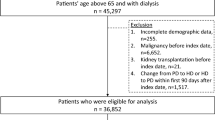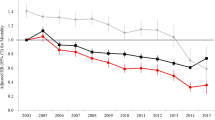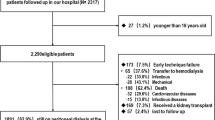Abstract
Objectives
The objective of the study is to identify and compare the different causes of death among peritoneal dialysis (PD) patients varying in baseline characteristics, including gender, age, primary diseases, and comorbidities and to assess risk factors for first-year death.
Methods
The clinical data of 179 PD patients who were regularly followed up in our hospital and died between January 2006 and February 2011 were retrospectively reviewed.
Results
Median age at PD catheter implantation was 73 years. The most common primary diseases leading to ESRD were diabetic nephropathy (DN; 26.3 %), chronic glomerulonephritis (CGN; 24.6 %), and hypertensive nephropathy (HN; 21.8 %). The main causes of death in the DN and CGN groups were infections (42.6 %) and cardiocerebrovascular accidents (34.1 %), respectively. Patients with systemic vasculitis (SV) had the highest mortality rate from infection (71.4 %). Cox regression model showed that, compared with patients with CGN, those who had primary disease of DN, renal amyloidosis, multiple myeloma, or vasculitis were at higher risk of first-year death. Cerebrovascular disease, chronic heart failure, and/or lower serum albumin at baseline were also risk factors for first-year death.
Conclusions
The main causes of death in PD patients with DN and CGN were infections and cardiocerebrovascular accidents, respectively. Risk factors for first-year death included the primary diseases, cerebrovascular diseases, chronic heart failure, and lower serum albumin at baseline.



Similar content being viewed by others
References
USRDS Annual Data Report (2012) http://www.usrds.org/atlas.aspx. Cited 17 Apr. 2013
Tokgoz B (2009) Clinical advantages of peritoneal dialysis. Perit Dial Int 29(Suppl 2):S59–S61
Sinnakirouchenan R, Holley JL (2011) Peritoneal dialysis versus hemodialysis: risks, benefits, and access issues. Adv Chronic Kidney Dis 18(6):428–432
Collins AJ, Foley RN, Gilbertson DT et al (2009) The state of chronic kidney disease, ESRD, and morbidity and mortality in the first year of dialysis. Clin J Am Soc Nephrol 4(Suppl 1):S5–S11
Al-Dadah A, Omran J, Nusair MB et al (2012) Cardiovascular mortality in dialysis patients. Adv Perit Dial 28:56–59
Williams VR, Quinn R, Callery S et al (2011) The impact of treatment modality on infection-related hospitalization rates in peritoneal dialysis and hemodialysis patients. Perit Dial Int 31(4):440–449
Sánchez-Perales C, Vázquez E, García-Cortés MJ et al (2010) Ischaemic stroke in incident dialysis patients. Nephrol Dial Transplant 25(10):3343–3348
Alexiewicz JM, Smogorzewski M, Akmal M et al (1996) Nifedipine reverses the abnormalities in [Ca2+]i and proliferation of B cells from dialysis patients. Kidney Int 50:1249–1254
Heidenreich S, Schmidt M, Bachmann J et al (1996) Apoptosis of monocytes cultured from long-term hemodialysis patients. Kidney Int 49:792–799
Vanholder R, Van Biesen W (2002) Incidence of infectious morbidity and mortality in dialysis patients. Blood Purif 20:477–480
Szeto CC, Wong TY, Chow KM et al (2003) Are peritoneal dialysis patients with and without residual renal function equivalent for survival study? Insight from a retrospective review of the cause of death. Nephrol Dial Transplant 18:977–982
Verdalles U, Abad S, Aragoncillo I et al (2010) Factors predicting mortality in elderly patients on dialysis. Nephron Clin Pract 115(1):c28–c34
Altieri P, Sau G, Cao R et al (2002) Immunosuppressive treatment in dialysis patients. Nephrol Dial Transplant 17(Suppl 8):2–9
Golper TA, Brier ME, Bunke M et al (1996) Risk factors for peritonitis in long-term peritoneal dialysis: the Network 9 peritonitis and catheter survival studies. Academic Subcommittee of the Steering Committee of the Network 9 Peritonitis and Catheter Survival Studies. Am J Kidney Dis 28:428–436
Andrews PA, Warr KJ, Hicks JA et al (1996) Impaired outcome of continuous ambulatory peritoneal dialysis in immunosuppressed patients. Nephrol Dial Transplant 11:1104–1108
Lamping DL, Constantinovici N, Roderick P et al (2000) Clinical outcomes, quality of life, and costs in the North Thames Dialysis Study of elderly people on dialysis: a prospective cohort study. Lancet 356:1543–1550
Couchoud C, Moranne O, Frimat L et al (2007) Associations between comorbidities, treatment choice and outcome in the elderly with end-stage renal disease. Nephrol Dial Transplant 22:3246–3254
Rumpsfeld M, McDonald SP, Johnson DW (2006) Higher peritoneal transport status is associated with higher mortality and technique failure in the Australian and New Zealand peritoneal dialysis patient populations. J Am Soc Nephrol 17:271–278
Booth AD, Almond MK, Burns A et al (2003) Outcome of ANCA-associated renal vasculitis: a 5-year retrospective study. Am J Kidney Dis 41:776–784
Bergesio F, Ciciani AM, Manganaro M et al (2008) Renal involvement in systemic amyloidosis: an Italian collaborative study on survival and renal outcome. Nephrol Dial Transplant 23(3):941–951
Knudsen LM, Hjorth M, Hippe E (2000) Renal failure in multiple myeloma: reversibility and impact on the prognosis. Nordic Myeloma Study Group. Eur J Haematol 65(3):175–181
Nordio M, Limido A, Maggiore U et al (2012) Survival in patients treated by long-term dialysis compared with the general population. Am J Kidney Dis 59(6):819–828
Young EW, Albert JM, Satayathum S et al (2005) Predictors and consequences of altered mineral metabolism: the Dialysis Outcomes and Practice Patterns Study. Kidney Int 67:1179–1187
Kopple JD (2005) The phenomenon of altered risk factor patterns or reverse epidemiology in persons with advanced chronic kidney failure. Am J Clin Nutr 81:1257–1266
Acknowledgments
We thank all the doctors and nurses involved in peritoneal dialysis for their work in following up PD patients. We also thank the PD patients and their family members for their cooperation.
Conflict of interest
None.
Author information
Authors and Affiliations
Corresponding author
Additional information
Qianying Zhang and Hong Ren have contributed equally to this work.
Rights and permissions
About this article
Cite this article
Zhang, Q., Ren, H., Xie, J. et al. Causes of death in peritoneal dialysis patients with different kidney diseases and comorbidities: a retrospective clinical analysis in a Chinese center. Int Urol Nephrol 46, 1201–1207 (2014). https://doi.org/10.1007/s11255-013-0561-5
Received:
Accepted:
Published:
Issue Date:
DOI: https://doi.org/10.1007/s11255-013-0561-5




